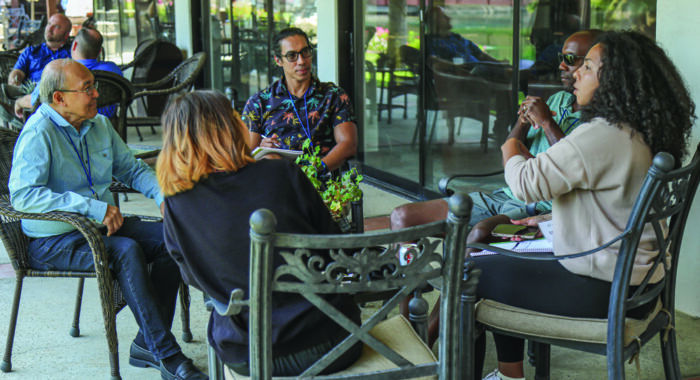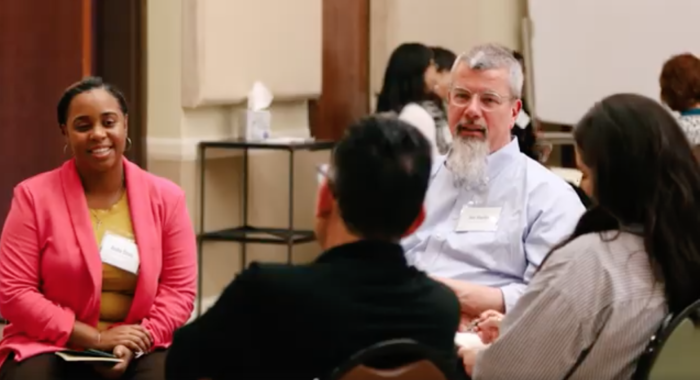Ian Hutchinson is professor of nuclear science and engineering at the Massachusetts Institute of Technology and researches plasma physics and its practical applications. He and his MIT team designed, built and operate the Alcator C-Mod tokamak, an international facility whose magnetically confined plasmas are prototypical of a future fusion reactor. He holds a bachelor’s degree in physics from Cambridge University and a Ph.D. in engineering physics from Australian National University.

In Today’s Conversation with Leith Anderson, Ian Hutchinson shares about his experience as a distinguished scientist and a committed Christian.
In this podcast, you’ll hear Leith and Ian discuss:
- Ian’s personal faith journey;
- The relationship between science and faith;
- How pastors can support scientists in their midst; and
- The important distinction between science and scientism.
Read a Portion of the Transcript
Leith: Let me start out and go right to a question that I’m sure you have been asked many times. What exactly is fusion plasma physics?
Ian: Fusion is a form of a nuclear energy that arises from reactions between the nuclei of our atoms in the regular world. And nuclear power, as we currently experience it, is based on fission that is breaking up heavy elements like uranium and that releases energy. But it turns out that if you take very light elements, like hydrogen and its isotopes, and fuse those together — we add them together, making heavy elements — that also releases energy, and that energy source (fusion energy) is the energy source of the sun and stars. And the question we’ve been researching for 60 years or so is: Can we bring that energy source of the sun and stars down to earth on the terrestrial human scale? And can we make it into a practical energy source, by which we can generate electricity and supply our energy needs? That’s been the aim of fusion research, and basically that’s the research — or the motivation at any rate for the research — I’ve been doing through most of my career. Plasmas — to address the other part of the title — plasmas are incredibly hot, ionized gases. They are gasses that are so hot that the electrons are stripped away from the nuclei. And the reason why we deal in those plasmas in fusion research is that in order to make fusion reactions take place you need extremely energetic collisions between the nuclei, and that requires extremely high temperatures — temperatures in the vicinity of 100 million degrees Celsius. That’s hotter than the center of the sun. And when you have some matter that is at such a high temperature, it becomes what’s called a plasma. So what I do — I and my colleagues here at MIT — is we study the behavior of these incredibly hot gasses called plasmas, combined using magnetic fields. If you have something that’s 100 million degrees centigrade you don’t just put it in a regular bottle because it would either vaporize the bottle or it would immediately cool the plasma down, so we confine it using magnetic fields — immaterial fields — and heat these plasmas. And we’re basically studying the behavior of plasmas combined by magnetic fields with a view to making fusion energy a human reality.
Leith: I looked up on the internet and found a picture of the equipment that you use, and it looks like a scene out of a science fiction movie. And it was an amazing piece of equipment. And shows your staff there, with you center in the staff picture, with this — what do we call the machine that you’re working with?
Ian: The type of confinement device I’m using is called a tokamak. And that basically refers to a toroidal — that is donut shaped plasma — held with a magnetic field in a chamber. But there are lots of very complicated pieces of equipment that generate the magnetic fields in the first place, that cool the magnets, that make the vacuum in which we generate the plasma, and so forth. But you referred to science fiction. Fusion made it into the movies in Spiderman and his interactions with Doctor Octopus. The type of fusion that’s often portrayed in these kinds of movie situations is kind of different from reality, but nevertheless it gives you something of the impression of the sort of complexity of the equipment that we’re studying. And so we have a major facility here at MIT that enables people to study these incredibly hot gasses. People come from all around the world to do experiments on the plasma trying to understand it better and trying to improve the design of a fusion reactor. There’s an experiment in the south of France called ITER — currently under construction — a much bigger version of the device — the tokamak — that we have here at MIT. It’s a much bigger version that if successful, will demonstrate a controlled fusion reaction — keeping itself hot using its own reactions and generating about 500 megawatts of power for hundreds of seconds at a time.
Leith: Yes, and that French research has been in the press, because I and others have read about it. I must admit I never would have associated Spiderman with MIT. I don’t know where he want to college but that is a surprise to me that I will long remember. So let’s switch a little bit here to talk about the faith aspect. Are there ways in your work that you see the workings of God?
Ian: Well, I think the workings of God are evident to everyone in a certain sense, because I see creation as a whole as being an act of God. God is the Creator. So when I’m studying natural sciences, I take myself to be studying the handiwork of God. So in that sense for any scientist there is a sense in which God is present in what they study. Of course for unbelieving scientists — for people who don’t recognize God — perhaps the Creator is unrecognized in the work that they do, but whoever we are in science, we can recognize the wonder of nature. And for me as a Christian that means the wonder of creation as well. So that’s the first thing I would point to in terms of God at work in my science. Science is indeed the study of God’s creation. There are many other ways in which I think God comes into my science as a Christian. I certainly think that when you think about scientists you think about people who are technically very knowledgeable and skillful. That’s an important part of science. But there are other parts of science, which are just as important, where I think the things we think of as more traditionally as being part of our relationship to God comes in. I’m thinking of interpersonal relationships. I’m thinking about leadership qualities, organization administration, dealing with people. I think all of those types of things are also an important part of science. And that’s something that I’ve learned over my career…
Share the Love
If you enjoyed the program, please rate it on iTunes and write a brief review. That will help get the word out and raise the visibility of the show.



 View All Podcasts
View All Podcasts 





























